Page 413 of 470
3
The vehicle is composed of a highvoltage battery that drives the
motor and air-conditioner, and an
auxiliary battery (12 V) that drives
the lamps, wipers, and audio sys-
tem.
The auxiliary battery is automati- cally charged when the vehicle is
in the ready ( ) mode or the high
voltage battery is being charged.
REVIEW OF ELECTRIC VEHICLE
Battery Information
Page 414 of 470
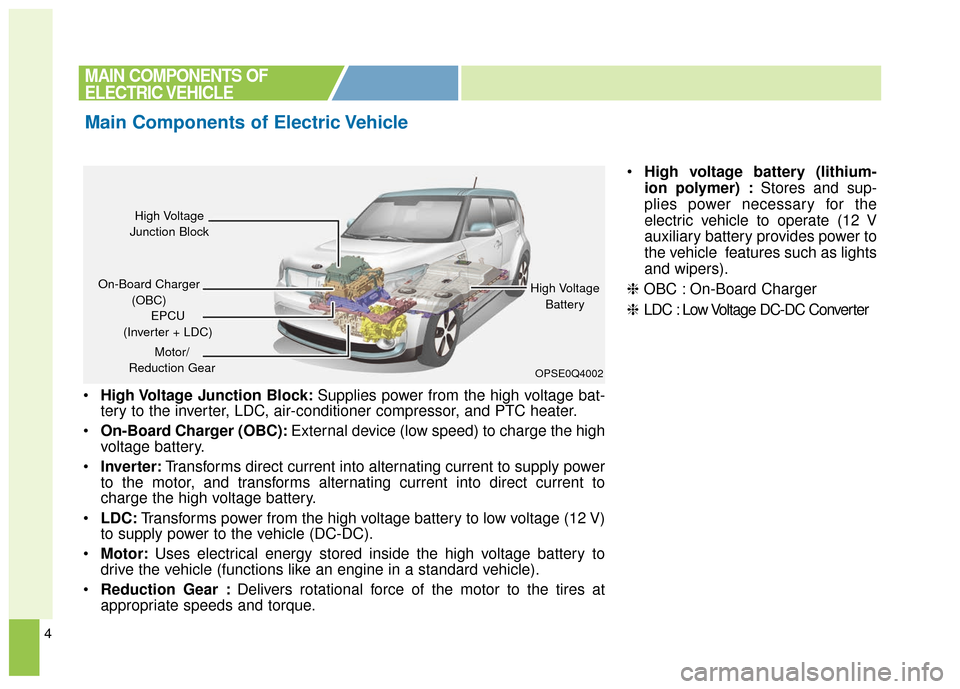
4
High Voltage Junction Block: Supplies power from the high voltage bat-
tery to the inverter, LDC, air-conditioner compressor, and PTC heater.
On-Board Charger (OBC): External device (low speed) to charge the high
voltage battery.
Inverter: Transforms direct current into alternating current to supply power
to the motor, and transforms alternating current into direct current to
charge the high voltage battery.
LDC: Transforms power from the high voltage battery to low voltage (12 V)
to supply power to the vehicle (DC-DC).
Motor: Uses electrical energy stored inside the high voltage battery to
drive the vehicle (functions like an engine in a standard vehicle).
Reduction Gear : Delivers rotational force of the motor to the tires at
appropriate speeds and torque.
High voltage battery (lithium-
ion polymer) : Stores and sup-
plies power necessary for the
electric vehicle to operate (12 V
auxiliary battery provides power to
the vehicle features such as lights
and wipers).
❈ OBC : On-Board Charger
❈ LDC : Low Voltage DC-DC Converter
MAIN COMPONENTS OF
ELECTRIC VEHICLE
Main Components of Electric Vehicle
OPSE0Q4002
High Voltage
Junction Block
On-Board Charger (OBC) High Voltage
Battery
EPCU
(Inverter + LDC)
Motor/
Reduction Gear
Page 415 of 470
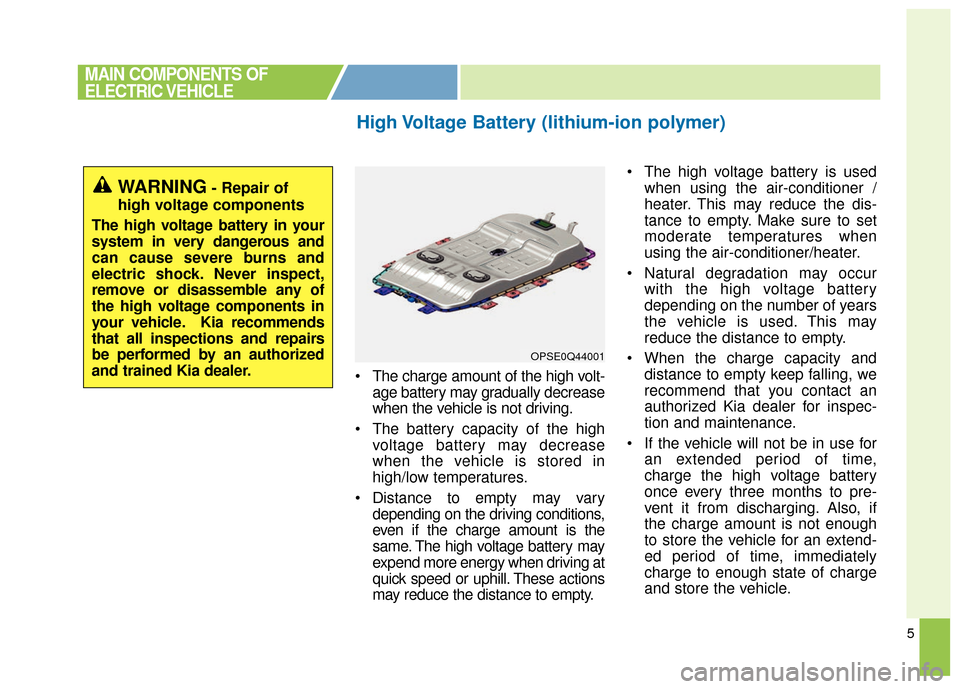
5
The charge amount of the high volt-age battery may gradually decrease
when the vehicle is not driving.
The battery capacity of the high voltage battery may decrease
when the vehicle is stored in
high/low temperatures.
Distance to empty may vary depending on the driving conditions,
even if the charge amount is the
same. The high voltage battery may
expend more energy when driving at
quick speed or uphill. These actions
may reduce the distance to empty. The high voltage battery is used
when using the air-conditioner /
heater. This may reduce the dis-
tance to empty. Make sure to set
moderate temperatures when
using the air-conditioner/heater.
Natural degradation may occur with the high voltage battery
depending on the number of years
the vehicle is used. This may
reduce the distance to empty.
When the charge capacity and distance to empty keep falling, we
recommend that you contact an
authorized Kia dealer for inspec-
tion and maintenance.
If the vehicle will not be in use for an extended period of time,
charge the high voltage battery
once every three months to pre-
vent it from discharging. Also, if
the charge amount is not enough
to store the vehicle for an extend-
ed period of time, immediately
charge to enough state of charge
and store the vehicle.
High Voltage Battery (lithium-ion polymer)
MAIN COMPONENTS OF
ELECTRIC VEHICLE
OPSE0Q44001
WARNING- Repair of
high voltage components
The high voltage battery in your
system in very dangerous and
can cause severe burns and
electric shock. Never inspect,
remove or disassemble any of
the high voltage components in
your vehicle. Kia recommends
that all inspections and repairs
be performed by an authorized
and trained Kia dealer.
Page 416 of 470
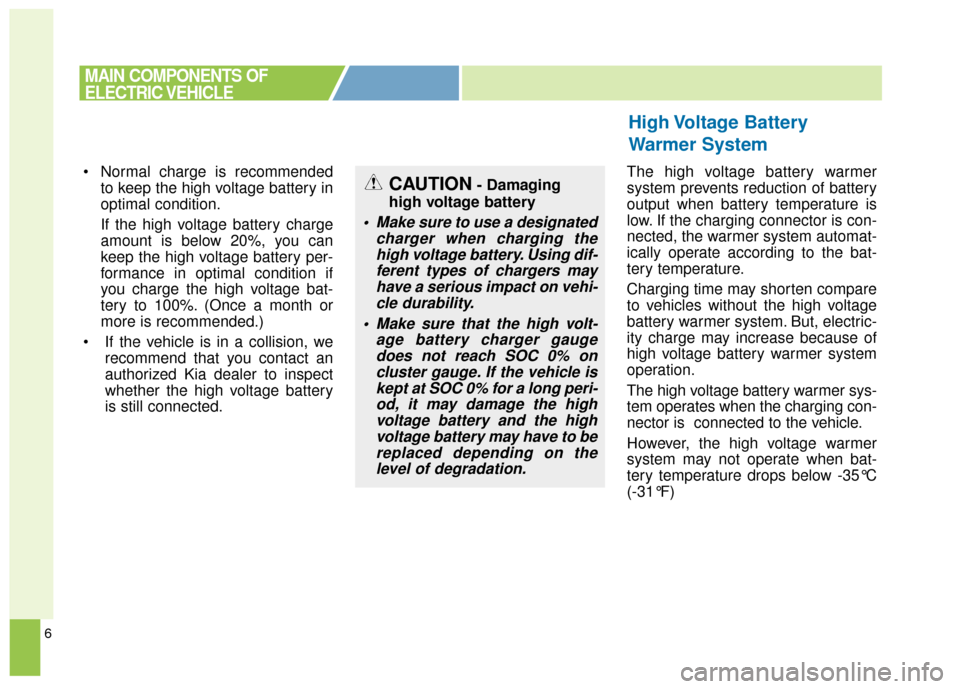
6
Normal charge is recommendedto keep the high voltage battery in
optimal condition.
If the high voltage battery charge
amount is below 20%, you can
keep the high voltage battery per-
formance in optimal condition if
you charge the high voltage bat-
tery to 100%. (Once a month or
more is recommended.)
If the vehicle is in a collision, we recommend that you contact an
authorized Kia dealer to inspect
whether the high voltage battery
is still connected. The high voltage battery warmer
system prevents reduction of battery
output when battery temperature is
low. If the charging connector is con-
nected, the warmer system automat-
ically operate according to the bat-
tery temperature.
Charging time may shorten compare
to vehicles without the high voltage
battery warmer system. But, electric-
ity charge may increase because of
high voltage battery warmer system
operation.
The high voltage battery warmer sys-
tem operates when the charging con-
nector is connected to the vehicle.
However, the high voltage warmer
system may not operate when bat-
tery temperature drops below -35°C
(-31°F)
High Voltage Battery
Warmer System
MAIN COMPONENTS OF
ELECTRIC VEHICLE
CAUTION- Damaging
high voltage battery
• Make sure to use a designated charger when charging thehigh voltage battery. Using dif-ferent types of chargers mayhave a serious impact on vehi-cle durability.
Make sure that the high volt- age battery charger gaugedoes not reach SOC 0% oncluster gauge. If the vehicle iskept at SOC 0% for a long peri-od, it may damage the highvoltage battery and the highvoltage battery may have to bereplaced depending on thelevel of degradation.
Page 423 of 470
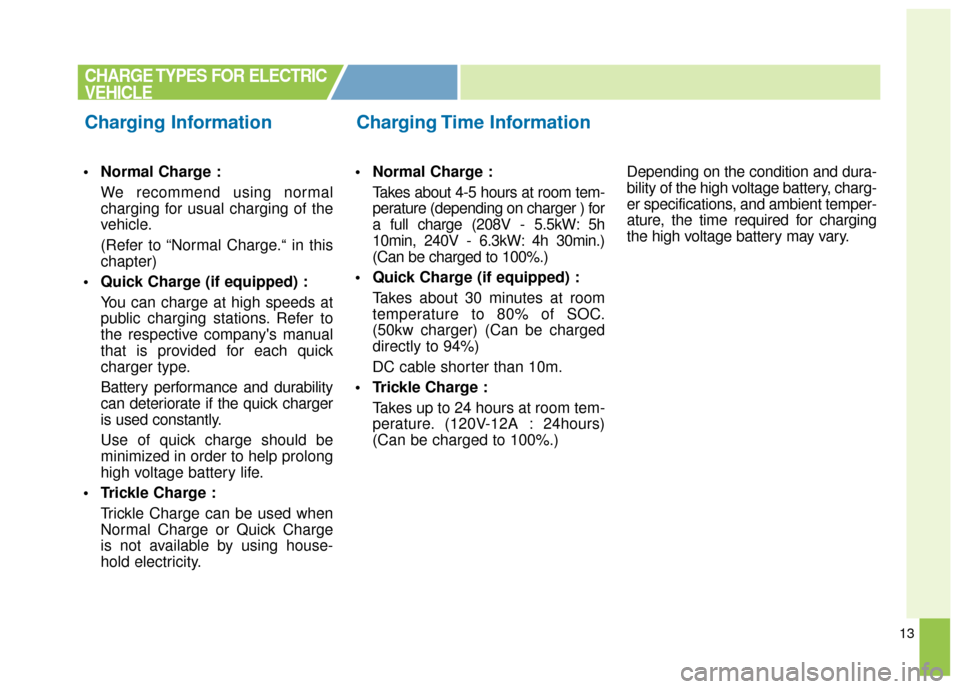
13
Normal Charge :We recommend using normal
charging for usual charging of the
vehicle.
(Refer to “Normal Charge.“ in this
chapter)
Quick Charge (if equipped) : You can charge at high speeds at
public charging stations. Refer to
the respective company's manual
that is provided for each quick
charger type.
Battery performance and durability
can deteriorate if the quick charger
is used constantly.
Use of quick charge should be
minimized in order to help prolong
high voltage battery life.
Trickle Charge : Trickle Charge can be used when
Normal Charge or Quick Charge
is not available by using house-
hold electricity. Normal Charge :
Takes about 4-5 hours at room tem-
perature (depending on charger ) for
a full charge (208V - 5.5kW: 5h
10min, 240V - 6.3kW: 4h 30min.)
(Can be charged to 100%.)
Quick Charge (if equipped) : Takes about 30 minutes at room
temperature to 80% of SOC.
(50kw charger) (Can be charged
directly to 94%)
DC cable shorter than 10m.
Trickle Charge : Takes up to 24 hours at room tem-
perature. (120V-12A : 24hours)
(Can be charged to 100%.) Depending on the condition and dura-
bility of the high voltage battery, charg-
er specifications, and ambient temper-
ature, the time required for charging
the high voltage battery may vary.
CHARGE TYPES FOR ELECTRIC
VEHICLE
Charging Information Charging Time Information
Page 424 of 470
14
CHARGE TYPES FOR ELECTRIC
VEHICLE
Charging Types
CategoryCharging Inlet(Vehicle)Charging ConnectorCharging OutletHow to ChargeCharging Time
Normal
Charge
Use the normal
charger that is
installed in your
home or public
charging stationApprox. 4-5 hours
(208V - 5.5kW: 5h
10min, 240V - 6.3kW:
4h 30min. room tem-
perature) (Can be
charged to 100% )
Quick
Charge
(if equipped)Use the quick
charger at public
charging stationApprox. 33 min
(50 kW, room tem-
perature) (Can be
charged to 94%)
Trickle
ChargeUse household
electricity
Approx. 24hours
(120V-12A: 24hours,
room temper-ature)
(Can be charged to
100%)
OPSE0Q4035
OPSE0Q4036
OPSE0Q4035
OPSE0Q4005
OPSE0Q4006
OPSE0Q4005
OPSE0Q4057N
OPSE0Q4004
OPSE0Q4007
❈Shape of charger and how to use the charger may be different for each manufacturer.
❈ Depending on the condition and durability of the high voltage battery, charger specifications, and ambient temper-
ature, the time required for charging the high voltage battery may vary.
Page 425 of 470
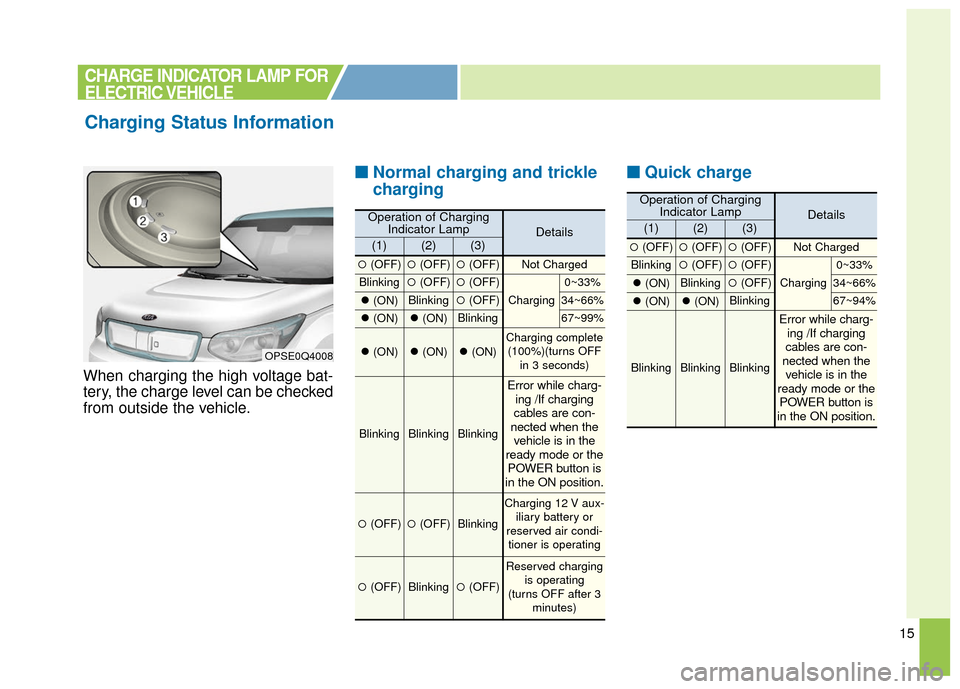
15
When charging the high voltage bat-
tery, the charge level can be checked
from outside the vehicle.
■ ■Normal charging and trickle
charging ■ ■
Quick charge
Charging Status Information
OPSE0Q4008
CHARGE INDICATOR LAMP FOR
ELECTRIC VEHICLE
Operation of Charging
Indicator LampDetails(1)(2)(3)
�(OFF)�(OFF)�(OFF)Not Charged
Blinking�(OFF)�(OFF)
Charging
0~33%
�(ON)Blinking�(OFF)34~66%
�(ON)�(ON)Blinking67~99%
�(ON)�(ON)�(ON)Charging complete
(100%)(turns OFF in 3 seconds)
BlinkingBlinkingBlinking
Error while charg-ing /If charging
cables are con-
nected when the vehicle is in the
ready mode or the POWER button is
in the ON position.
�(OFF)�(OFF)Blinking
Charging 12 V aux-
iliary battery or
reserved air condi- tioner is operating
�(OFF)Blinking�(OFF)
Reserved charging is operating
(turns OFF after 3 minutes)
Operation of ChargingIndicator LampDetails(1)(2)(3)
�(OFF)�(OFF)�(OFF)Not Charged
Blinking�(OFF)�(OFF)
Charging
0~33%
�(ON)Blinking�(OFF)34~66%
�(ON)�(ON)Blinking67~94%
BlinkingBlinkingBlinking
Error while charg-
ing /If charging
cables are con-
nected when the vehicle is in the
ready mode or the POWER button is
in the ON position.
Page 434 of 470
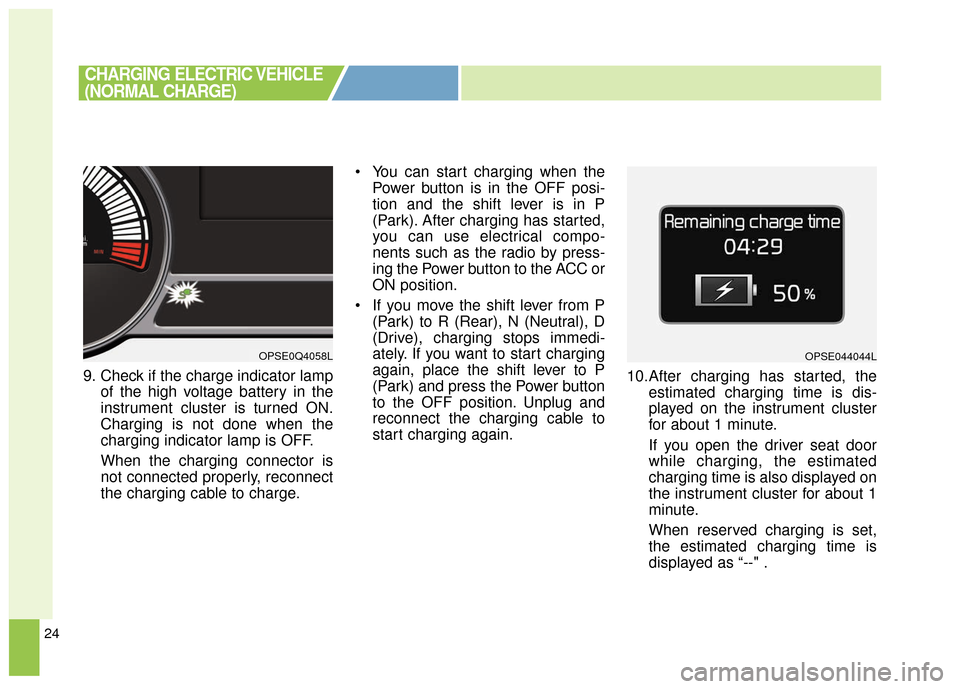
24
9. Check if the charge indicator lampof the high voltage battery in the
instrument cluster is turned ON.
Charging is not done when the
charging indicator lamp is OFF.
When the charging connector is
not connected properly, reconnect
the charging cable to charge. You can start charging when the
Power button is in the OFF posi-
tion and the shift lever is in P
(Park). After charging has started,
you can use electrical compo-
nents such as the radio by press-
ing the Power button to the ACC or
ON position.
If you move the shift lever from P (Park) to R (Rear), N (Neutral), D
(Drive), charging stops immedi-
ately. If you want to start charging
again, place the shift lever to P
(Park) and press the Power button
to the OFF position. Unplug and
reconnect the charging cable to
start charging again. 10.After charging has started, the
estimated charging time is dis-
played on the instrument cluster
for about 1 minute.
If you open the driver seat door
while charging, the estimated
charging time is also displayed on
the instrument cluster for about 1
minute.
When reserved charging is set,
the estimated charging time is
displayed as “--" .
OPSE0Q4058LOPSE044044L
CHARGING ELECTRIC VEHICLE
(NORMAL CHARGE)